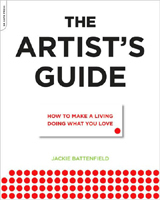Artists: How to Earn and Manage Money, Part I (2009)
The following is an excerpt from Jackie Battenfield’s The Artist’s Guide: How to make a living doing what you love.
Creative Business & Entrepreneurship | 21 January 2011
Artists: How to Earn and Manage Money
Let’s face it, no one chooses to be an artist for the money, so supporting your practice can produce emotional knots difficult to untangle. Money is a delicate subject no matter what field you are in. Many people find it easier to talk about their sex lives than their bank accounts. If money were all you were after, there are many other professions with high income potential. If you are like me, you keep at it because you are driven to create and can’t imagine doing anything else with your life. For better or for worse, you know this is where you belong. Being an artist shouldn’t mean all or nothing financially. Unfortunately, the image promoted in the media focuses on art stars and their extravagant behavior. It’s rare to find a profile about an artist who is just nicely chugging along. Thus we internalize a negative image of the art profession as one of extreme opposites— rich or poor, success or failure— without any vision of the middle path that most of us will find to be our reality. For the rest of this chapter you need to try to put that emotional baggage aside and face up to your financial responsibility. Ask yourself, “What is the best way I can fund my practice?”
Talent and money are two separate things; don’t mix them up. In order to be free to strategize how you will support your work, you need to begin to separate any emotions that connect money to talent. Remind yourself that the same individuality you have established in your art practice will uncover a unique path to funding your art.
Let’s start with defining what money is to your art practice. Money is a tool that provides the means to buy supplies, assistance, space to work, and most importantly time to develop and realize new ideas in your studio. It also covers your personal needs of food, shelter, and fun. How you acquire and manage your money to carry through your ideas, support your practice, and sustain your personal life while maintaining your integrity is vitally important to your sense of well-being.
I can guarantee you that dedicating the time and actions to organize your finances will free up wasted emotional energy fretting over the bills coming in. Van Gogh’s letters to his brother are a poignant example of the time and energy spent on the quest for money. Nothing is free, not even handouts from your sympathetic brother. Yet, again and again, the saga of genius coupled with unremitting poverty underlies our view of an artist’s life, Van Gogh’s being the classic example. This myth is potent. For you to tackle it is courageous and psychologically essential to your health as an artist.
Part I | Artists: How to Earn and Manage Money, Part II
This excerpt is on pages 161-162 in the chapter: “How to Earn and Manage Money”. The Artist’s Guide: How to make a living doing what you love (2009) is published by Da Capo Press. For more information and reviews, click the link above the article.
